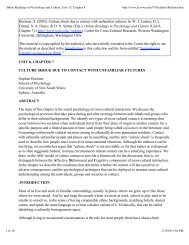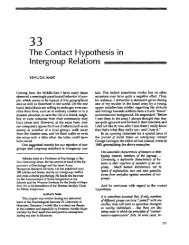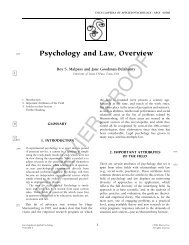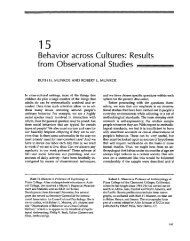From the Lab to the Police Station - Eyewitness Identification Lab ...
From the Lab to the Police Station - Eyewitness Identification Lab ...
From the Lab to the Police Station - Eyewitness Identification Lab ...
Create successful ePaper yourself
Turn your PDF publications into a flip-book with our unique Google optimized e-Paper software.
Although <strong>the</strong> courts were increasingly permitting expert testimony,<br />
<strong>the</strong>re were no serious attempts by <strong>the</strong> justice system <strong>to</strong><br />
use <strong>the</strong> psychological literature <strong>to</strong> address <strong>the</strong> issue of eyewitness<br />
reliability until <strong>the</strong> DNA exoneration cases caught <strong>the</strong><br />
attention of <strong>the</strong> U.S. Department of Justice.<br />
The role of <strong>the</strong> DNA exoneration cases in propelling<br />
<strong>the</strong> justice system <strong>to</strong> take seriously <strong>the</strong> issue of eyewitness<br />
evidence struck many eyewitness researchers as odd. <strong>Eyewitness</strong><br />
researchers generally believed that <strong>the</strong> experimental<br />
literature in psychology had already made a much<br />
stronger and more informative case for reform than any<br />
collection of case studies could possibly muster. Never<strong>the</strong>less,<br />
<strong>the</strong> published literature in psychology, expert testimony<br />
by psychologists, and media exposure were not in<br />
and of <strong>the</strong>mselves sufficient pressure points on <strong>the</strong> justice<br />
system <strong>to</strong> awaken policymakers <strong>to</strong> <strong>the</strong> problems with eyewitness<br />
evidence.<br />
The experience in England and Wales has been similar<br />
in <strong>the</strong> sense that it <strong>to</strong>ok salient miscarriages of justice for<br />
<strong>the</strong> law <strong>to</strong> recognize that psychologists might have something<br />
important <strong>to</strong> offer. The Devlin report (1976), commissioned<br />
by <strong>the</strong> Secretary of State for <strong>the</strong> Home Department<br />
in London, reviewed 36 cases of misidentification.<br />
These case studies, although not scientific, helped create a<br />
foundation for interest in scientific psychological research<br />
on eyewitness issues in England and Wales. Key eyewitness<br />
researchers in <strong>the</strong> United Kingdom, such as Graham<br />
Davies and Ray Bull, have since managed <strong>to</strong> have considerable<br />
impact on <strong>the</strong> law and practices in England and<br />
Wales, especially with regard <strong>to</strong> child witnesses (Bull,<br />
1992) and police composites (Davies, Shepherd, Shepherd,<br />
Flin, & Ellis, 1986). The Memorandum of Good Practice<br />
on Video-Recorded Interviews With Child Witnesses for<br />
Criminal Proceedings (1992), for example, is loaded with<br />
psychological research findings and is closely in line with<br />
psychological science. As with <strong>the</strong> experience in <strong>the</strong> United<br />
States, it seemed that <strong>the</strong> process needed <strong>to</strong> be jump-started<br />
by publicized miscarriages of justice.<br />
JANET RENO AND THE INITIATION<br />
OF GUIDELINES FOR EYEWITNESS<br />
EVIDENCE<br />
In 1995, <strong>the</strong> National Institute of Justice (NIJ), <strong>the</strong> research<br />
and development arm of <strong>the</strong> Department of Justice, launched<br />
a review of cases in which persons were released from prison<br />
as a result of posttrial DNA testing of evidence. The resulting<br />
report, released in 1996, showed that 80% of <strong>the</strong>se innocent<br />
people had been mistakenly identified by eyewitnesses (Connors<br />
et al, 1996). U.S. At<strong>to</strong>rney General Janet Reno, on<br />
reading this report, became highly concerned. In early 1997,<br />
one of <strong>the</strong> current authors (Gary L. Wells) met with Reno <strong>to</strong><br />
discuss <strong>the</strong> meaning of <strong>the</strong> pattern of misidentification. Reno<br />
had already read a couple of key articles on eyewitness identification,<br />
including an American Psychologist article that<br />
spelled out ways in which <strong>the</strong> justice system could improve<br />
<strong>the</strong> accuracy of eyewitness identification evidence (Wells,<br />
1993). Reno later ordered that a panel be formed <strong>to</strong> address<br />
this concern; by early 1998, that panel had been formed and<br />
began meeting.<br />
The effort <strong>to</strong> develop national guidelines for <strong>the</strong> collection<br />
of eyewitness evidence was directed by <strong>the</strong> NIJ.<br />
Richard Rau, an experienced NIJ direc<strong>to</strong>r, was appointed as<br />
<strong>the</strong> project manager. Two researchers (Gary L. Wells and<br />
Ronatd P. Fisher), 2 prosecu<strong>to</strong>rs (Melissa Mourges, an<br />
assistant district at<strong>to</strong>rney in Manhattan, and Mark Larson,<br />
chief criminal deputy in <strong>the</strong> King's County Prosecu<strong>to</strong>r's<br />
Office in Seattle, Washing<strong>to</strong>n), 1 defense lawyer (James<br />
Doyle, a Bos<strong>to</strong>n lawyer who writes on eyewitness issues),<br />
and 2 law enforcement members (Don Mauro, a Los Angeles<br />
homicide captain, and Paul Carroll, a retired Chicago<br />
<strong>Police</strong> Department sergeant) constituted <strong>the</strong> original panel.<br />
Later, ano<strong>the</strong>r law enforcement person (Ella Bully, a commander<br />
with <strong>the</strong> Detroit <strong>Police</strong> Department) was added <strong>to</strong><br />
<strong>the</strong> panel. After several meetings, mostly in Washing<strong>to</strong>n,<br />
DC, but also Chicago and Atlanta, Georgia, a working<br />
group was formed. The working group included an additional<br />
4 eyewitness researchers (Roy S. Malpass, R. C. L.<br />
Lindsay, John W. Turtle, and Solomon M. Fulero), 14 law<br />
enforcement persons (from 13 different states), 4 prosecu<strong>to</strong>rs,<br />
and 3 defense lawyers. The full working group (which<br />
included <strong>the</strong> panel plus <strong>the</strong> additional 25 members) met for<br />
<strong>the</strong> first time in Oc<strong>to</strong>ber 1998 in Chicago; that meeting was<br />
followed by meetings in January 1999 (Washing<strong>to</strong>n, DC)<br />
and May 1999 (San Francisco), at which point a draft of <strong>the</strong><br />
guidelines was finalized and approved. 5<br />
Although <strong>the</strong> involvement of eyewitness research and<br />
eyewitness researchers in <strong>the</strong> creation of law enforcement<br />
eyewitness evidence guidelines is unique in <strong>the</strong> United<br />
States, <strong>the</strong>re have been successful efforts in England and<br />
Wales <strong>to</strong> incorporate <strong>the</strong> scientific eyewitness literature<br />
in<strong>to</strong> <strong>the</strong>ir Memorandum of Good Practice on Video-<br />
Recorded Interviews With Child Witnesses for Criminal<br />
Proceedings (1992), which governs police conduct. In addition,<br />
<strong>the</strong> Law Reform Commission of Canada (1983)<br />
relied on <strong>the</strong> scientific eyewitness literature in 1983 when<br />
developing recommendations on eyewitness evidence. Recently,<br />
Israeli police have made use of recommendations<br />
from eyewitness researcher Avaraham Levi regarding<br />
lineup procedures. However, those countries have relatively<br />
centralized systems governing <strong>the</strong>ir police, whereas<br />
<strong>the</strong> police system in <strong>the</strong> United States is a complex, multileveled,<br />
quasi-independent system of federal, state, and<br />
local jurisdictions. For this reason, <strong>the</strong> inclusion of law<br />
enforcement members, prosecu<strong>to</strong>rs, and defense lawyers<br />
from across <strong>the</strong> country in <strong>the</strong> working group was essential<br />
<strong>to</strong> <strong>the</strong> success of this effort. The absence of a central body<br />
governing police procedures in <strong>the</strong> United States made it<br />
necessary <strong>to</strong> involve all of <strong>the</strong>se constituencies and <strong>to</strong> reach<br />
a consensus for <strong>the</strong> product <strong>to</strong> be accepted.<br />
The Process: Pleasant and<br />
Unpleasant Surprises<br />
The Guide was almost entirely written during <strong>the</strong> meetings of<br />
<strong>the</strong> full working group. Subgroups drafted sections, but <strong>the</strong><br />
5 The panel and working group are now meeting <strong>to</strong> formulate national<br />
plans for training law enforcement officers on <strong>the</strong> procedures.<br />
590 June 2000 • American Psychologist







